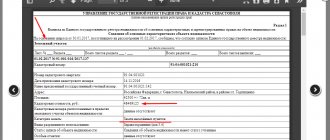Concept, functions and purposes of the transfer deed
A deed of transfer is a document defining the rights and obligations of legal entities during reorganization. In essence, reorganization is one of the forms of termination of the existence of a legal entity with the transfer of rights and obligations to another legal entity.
The definition of a document is enshrined in the provisions of the Civil Code. Article 58 states that this form of transfer of rights and obligations is not suitable for all reorganization options. There is no need to draw up these acts during annexation, merger, or transformation. When selecting and dividing, you must create such a document.
The law does not provide for a clear form of drawing up the document. The transfer deed must contain a number of provisions that reflect:
- Accounts payable and receivable;
- Various forms of obligations;
- List of property that belongs to the entity subject to reorganization.
In the process of reorganization, the transfer act is used to compile a list and delineate the responsibilities and rights of participants in the process of reorganization of a legal entity:
- Includes a list of rights that are transferred from one subject to another;
- Contains a list of property transferred during the reorganization process;
- The transfer act during reorganization allows you to regulate the level of responsibility and obligations of legal entities.
The transfer act is drawn up on the basis of the inventory procedure of the property of the legal entity whose reorganization is being carried out.
The obligations of a legal entity are also subject to inventory. The document is subject to approval by the body that decided on the need for transformation, or by the founders of the enterprise.
If it is necessary to register new entities created in the process of reorganization by separation, or if it is necessary to make changes to the main documents of a legal entity, the procedure requires the preparation of a transfer act.
According to the law, if there is no transfer deed or there are no provisions on the legal successor in the document drawn up, the authorized authorities may refuse to register the new entity formed as a result of the transformations.
Structure
Now we will analyze the rules for drawing up such an act step by step. What should be written in it, and how to format it correctly.
There are standard forms to fill out, but the law does not prohibit drawing up such a document in simple written form. This document must contain the following information:
Title of the document.- Information about the main document to which this act is an annex. Name, number and date of signing.
- Place and time.
- Data from both sides.
- Description of the transfer object, its purpose and name, address, floor, area, location of rooms and other characteristics.
- You can describe the existing metering devices - gas, water and electric meters, and also record the readings on them.
- If desired, you can list the existing pieces of furniture and household appliances.
- It is necessary to assess the condition of the apartment and other property.
- If renovations have recently been made, or new windows or doors have been installed, it would be a good idea to enter information about this fact.
- The document also includes information about any deficiencies found, such as a broken faucet or damaged furniture upholstery.
- The transferred keys to the apartment, entrance, basement, etc. are indicated.
- If additional premises are provided in the form of a basement or garage, then they are also indicated, inspected and described.
- At the end, the document is signed by both parties with a transcript of the signature.
Participants
The act is signed by the tenant and the owner of the property. Also, the signature can be put by the owner’s authorized representative if he has a notarized power of attorney for such actions. It is better if both the lease agreement and the transfer deed are signed by the same people, although this is not necessary.
A transfer act is drawn up in two copies: one for the owner and the other for the tenant of the apartment. As is the lease agreement to which it is attached.
It is important to verify the identity of the copies of documents and the presence of the necessary signatures on them.
Place of signing
The act is drawn up in the premises that are rented in order to clearly demonstrate everything that is described in the document and to make additions, if necessary.
Registration
There is no need to register the act itself; it will not even be accepted for registration. It is only possible to register a residential lease agreement if it is concluded for a period of more than one year.
Validity
By default, the act is valid for the duration of the main document, that is, the rental agreement for residential premises.
In fact, this document is only an appendix that records the condition of the owner’s property, which he transfers to the tenant. Therefore, the act itself does not have any deadlines; only the contract has a deadline.
State duty
The deed of transfer does not require state registration or notarization, so no fees or other costs will be required.
Methods for reorganizing a legal entity
Reorganization, as a form of termination of the existence of a legal entity or its transformation, can be carried out in the following ways:
- Spin-off: one enterprise is formed by spinning off several or one new one. Part of the rights and obligations is transferred to the new legal entity or entities.
- Division: A business ceases to exist by dividing into new legal entities that assume rights and obligations.
- Transformation: involves changing the form and organization of the enterprise.
- Merger: the combination of enterprises by terminating the activities of the legal entities that they were before the merger process began.
- Merger: two or more legal entities cease to exist by merging with another entity, transferring their rights and obligations to that entity.
The rules governing the reorganization process are specified in laws and regulations.
Paper Features
The property located in the apartment must be included in the deed. Assess the condition of the items, possible deficiencies, their approximate cost, and degree of wear. This includes household appliances, furniture, plumbing fixtures, lighting fixtures, interior doors, double-glazed windows, even bedding.
The act must indicate everything that is of value, for damage to which the owner is ready to make claims.
Example: A Veka two-chamber refrigerator is working properly, it was purchased at a household appliance store 4 months ago for 15,000 rubles, there is a scratch on the freezer door 4 cm long. There is a receipt.
A detailed description of the property is also beneficial to the tenant, then he can safely say that some damage had already occurred before his arrival in the apartment.
Form, procedure for drawing up the transfer deed
According to the legislation, there is no specific universal form for drawing up a document. The procedure for filling out the act implies the mandatory inclusion in the text of the document of the rights and obligations that are transferred to the legal successor. The transfer deed states the fact of transfer of rights and obligations to the legal successor. A mandatory requirement is the approval of the act by the persons who are the authors of the idea of reorganizing the legal entity. It is worth noting that the absence of a provision on a legal successor may become a basis for refusal if, after the reorganization, it is planned to form a new legal entity.
The document includes several mandatory provisions: name, date, place of registration, confirmation of the transfer of responsibilities and rights to another or other legal entities, the amount of debts, a list of property that is transferred by the reorganized legal entity to the successor, obligations are indicated, signatures that certify the document.
It is imperative to approve the fact of transfer of obligations and rights by the persons who made the decision on the reorganization. The general form and procedure for filling out is free.
The clause confirming the transfer of rights and obligations requires precise indication of the names of the companies between which the agreement is concluded. The list of property that contains the transfer deed necessarily includes the value of this property at the time of signing.
In some cases, if the lists of property, liabilities and assets are extensive, the preparation of appendices is required. The number of documents drawn up depends on the form of reorganization. For example, during a merger, each party draws up a transfer deed.
It is worth noting that this document is not considered mandatory for some forms of reorganization, but the provisions of the Civil Code note the special importance of the document during reorganization.
Subtleties of drafting
The act of transferring the apartment and property is usually drawn up in two copies - one for the landlord, the second for the tenant. However, if the contract is concluded through an intermediary, then it is necessary to make a third copy for him. It should also contain three personal data and signatures.
If necessary, the apartment owner can specifically designate those interior items that the tenant does not have the right to remove from the apartment or use at all.
It is possible to indicate the approximate market value of each unit of transferred property - this will help in the event of litigation to establish the amount of damage. In general, all numbers in the act can be written both in numbers and in words, which will be additional protection against retroactive corrections.
If any defect was discovered and there is no disagreement about how to eliminate it, then the act states that the lessor (tenant) undertakes to eliminate it on his own and within a specific period.
You can attach printed photographs of problem areas in the house to the deed, which must be signed by both parties and indicate the date. In this case, an additional clause is introduced into the act, indicating the number of photographs attached. Sometimes an apartment plan from the BTI appears as an appendix. In this way, the landlord can protect himself from possible unauthorized redevelopment.
It happens that when transferring an apartment or private residential building, the tenant is given the keys to the basement, closet, or attic along with them. These facts must be reflected when drawing up the act.
After the end of the rental period, it is also advisable to return the apartment using a transfer deed. In it, the parties change places - the tenant transfers, and the landlord accepts, the living space; it is necessary to accurately record the condition of the apartment, furniture and appliances at the time of the tenant's departure. In the future, this will make it possible to accurately determine what is unnecessary in the apartment and what has disappeared, how the condition of things and the appearance of the room has changed.
When transferring an apartment for rent, the parties must draw up an act of transfer of the apartment and property, which is an annex to the agreement.
It describes in detail the condition of the premises, the presence and condition of furniture, household appliances, and interior items.
Retransfer at the end of the contract is also carried out using a deed. A detailed report is evidence of the presence or absence of any defects in the property in the event of a trial.
Features of the content of the transfer deed
The transfer act includes information that confirms the transfer of rights and obligations from one legal entity to another. This is the most important provision in the act. The document is drawn up in free form - there is no universal template approved by law.
You must specify:
- Names of organizations that participate in the reorganization;
- Date and place of document preparation;
- Confirmation of the fact of transfer of rights and obligations;
- List of transferred property indicating their value (at the time of signing the document;
- List of debts;
- Approval of the act has the most important legal significance.
Notification of the start of the reorganization procedure requires indication of the parties to the agreement, the form of reorganization, the date, and the number of participants in the process.
The authorized tax service may refuse to approve a document if it does not contain a provision on the transfer of rights and obligations or the act is not submitted to the body that deals with state registration.
The act of acceptance and transfer of an apartment under a rental agreement: form
_______________ "____" ________________ 201__.
_____________________________________________________________________________________

2. Availability of a telephone in the apartment ____________ tel. No. _______________________________
3. Electricity meter readings on the date of entry - “_____” _____________________ (_______________)
________________________________________________________________________________________________________________________________________________________________________________________________________________________________________________________________________________________________________________________________________
6. The residential premises are suitable for living, are in satisfactory condition and have no
defects other than those specified in clause 5 of this Transfer and Acceptance Certificate.
7. When signing this Transfer and Acceptance Certificate, the Landlord handed over, and the Tenant accepted, the keys to the residential premises, receipt forms for payment in accordance with the agreement in clause 4.5. Lease agreements.
8. When signing this Transfer and Acceptance Certificate, the Tenant transferred and the Lessor accepted
_______________ (_____________________________________________)___________, the remaining part
in the amount of ____________ (__________________________________________________________)__________, Tenant
undertakes to transfer ________________________________________________________________.
9. This Transfer and Acceptance Certificate is drawn up in two copies having equal legal force, and is an integral part of the Residential Lease Agreement dated “____” ________________ 201__ for each of the parties.
TRANSMITTED “___” ______________ 201__.
Lessor: _______________________/____________________/
ACCEPTED "___" _______________ 201___,
Employer: _______________________/____________________/
Gr. (Full name)_________________________________________________________________, hereinafter referred to as the lessor, on the one hand, and _______________________________________ _____________________________________________________, hereinafter referred to as the tenant, on the other hand, hereinafter referred to as the parties, have drawn up this act as follows: 1.
In accordance with the rental agreement, the landlord transferred, and the tenant accepted for temporary paid possession and use of ____ one-room apartment (room), located at the address: _________________________________________________, hereinafter referred to as the apartment, keys, as well as property, in accordance with paragraph.
3 of this act. 2. During the inspection, the following condition of the objects was established: - plumbing ______________________________________________________________________________ - floor ______________________________________________________________________________ - ceiling ___________________________________________________________________________ - walls ___________________________________________________________________________ - windows ___________________________________________________________________________ - electrical wiring ___________________________________________________________________________ - doors ___________________________________________________________________________ - other ___________________________________________________________________________
3.
Together with the apartment, the lessor transferred and the tenant accepted for temporary paid possession and use the following property: ___________________________________________________________________________ ___________________________________________________________________________ ___________________________________________________________________________ ___________________________________________________________________________ ___________________________________________________________________________ ___________________________________________________________________________ ___________________________________________________________________________ ___________________________________________________________________________ ___________________________________________________________________________ ___________________________________________________________________________ 4.
The electric meter readings on the day of signing this act are ___________ 5. The readings of the cold water consumption meter (meter) on the day of signing this act are _______________________________________________________________________ 6. The readings of the hot water consumption meter (meter) on the day of signing this act are _______________________________________________________________________ 7.
What do you need to know about potential residency applicants?
Persons and bodies approving the transfer deed
The decision to transfer rights and obligations from one organization to another is made by decision of the participants of the legal entity. In addition to the company's participants, a decision on reorganization can be made by another body that, by law, has such rights. If the organization is unitary, the main decision is made by the person who is the owner of the property.
If reorganization occurs in joint-stock companies, the decision on reorganization is made by the meeting of shareholders - this is required to avoid conflict situations.
The exact list of persons who approve the document is not specified in laws and regulations. The main factor that influences the list of persons approving a document is the form of reorganization:
- Merger and transformation: the signature of the head of the enterprise is required, who transfers rights and responsibilities. Reason: The receiving party cannot approve the document yet because it does not exist.
- Accession: Since both organizations, receiving and transferring, exist, the signatures of the counterparties involved in the accession are required.
The notification of the beginning of the reorganization procedure is drawn up in a form with a precise indication of the parties with the names of the reorganization form and other data.
Reorganization by any means requires approval of the document by the parties, and confirmation in writing of the fact of transfer of rights and obligations.
Author of the article
Information for the document
The act of acceptance and transfer of an apartment for rent is a document in which data is entered about the apartment, the things in it in the form of furniture, household appliances, etc., and their condition. This list also includes the keys to the apartment, entrance and documents handed over to the tenant. That is, in essence, this is an inventory of property and documents that are transferred for temporary use under a lease agreement.
We suggest you read: Is it possible to start privatizing an apartment without registration in it?
Property inventory is a document that is
annex to the agreement
. Without it, the act has no legal force.
At the end of the rental period, a reverse action is possible by drawing up an act of transferring the apartment from the tenant to the owner. In general, such an act is not mandatory by law; the initiative to draw it up must come from one of the parties.
Why do you need a deed of transfer of an apartment from the tenant to the owner:
- The act prevents frivolous claims by the landlord for damage to property.
- Helps the owner substantiate real claims regarding the condition of the apartment and other property.
The act of acceptance and transfer of housing is not a mandatory condition of the housing rental agreement, but determines the moment of transfer of housing to the tenant and records the condition of the housing and things transferred by the landlord for temporary use and possession.
Contents of the act
The acceptance certificate can be included in the rental agreement at the request of the parties. The act is drawn up in any form, but in order for it to have legal force, it must reflect the following points:
- Place and time of drawing up the document.
- Number and date of registration of the rental agreement.
- Data of the parties to the contract. For individuals – full name and passport details. For legal entities - the full name of the organization and IIN.
- Condition of housing. Availability of repairs, with clarification of its type - major, partial, fine finishing, etc. Improvements made by the landlord that have become an integral part of the housing may be indicated.
- If, during inspection by the tenant, any defects were discovered in the rental housing, this must be reflected in the report. If no deficiencies are found, then it is advisable to record this in the act.
- Signatures of the parties. If one of the parties is a legal entity, then the seal of the enterprise is affixed.
When signing the act, the tenant is given the keys to the premises and a security deposit, if it was provided for in the rental agreement.
Insurance deposit
The concept of a security deposit is not reflected in the current legislation of the Russian Federation; this concept was developed by practice and, in fact, reflects the collateral relations provided for in Art. 329, 334 of the Civil Code of the Russian Federation.
Its main difference is that the security deposit is actually provided not to secure obligations, as is done in the case of a pledge, but to ensure a guarantee obligation to preserve the housing in proper condition during its use and disposal.
Article 1064 of the Civil Code of the Russian Federation provides for compensation for damage by the tenant if, during the operation of the apartment, damage was caused to him, for example, property or household appliances provided to him by the landlord for temporary possession and use were damaged.
In this case, the insurance deposit will serve as a guarantee of compensation for damage caused. In addition, he can ensure payment of the last term of the tenant’s stay and payment of utility bills in full.
As a rule, the amount of the security deposit pays for the last month of the tenant’s stay in the residential premises; in this case, there is no violation of the contract.
In the contract, these concepts can be separated and, by agreement, oblige the tenant to make payment independently; in this case, the amount of the security deposit, in the absence of property damage, is fully returned to the tenant, and can be transferred under the acceptance certificate.
If the act is an integral condition of the residential lease agreement, then its preparation must necessarily be contained in the terms of the agreement being concluded, and the act itself must indicate by virtue of the execution of which agreement it is being drawn up.
If the drawing up of an act is not reflected in the agreement, then the act itself shall indicate the contractual relations that became the basis for drawing up this act.
If the time of drawing up and signing the act for some reason does not coincide with the very fact of handing over the keys to the apartment to the tenant, then this should also be reflected in the act.
Important! Before signing the acceptance certificate, it is necessary to carefully inspect the apartment, including the furniture, household appliances and plumbing fixtures located in it. Check their functionality. Otherwise, you will have to compensate for the damage caused if the detected defects are not reflected in the act.
To complete the compilation, you can indicate not only the condition of the housing as a whole, but also its individual components - doors, windows, walls, balconies, etc.
We invite you to read: Traffic rules when entering and leaving the yard in 2019





